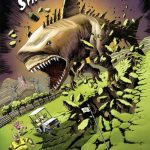-
Written by Hugh Goldring; illustrated by Nicole Burton
Ad Astra Comix
2018/$15/118 pp.
-
Written and drawn by Ben Rankel
Renegade Arts Entertainment
2018/$25/112 pp.
-
Written by Spencer Estabrooks; illustrations by Jethro Morales
Renegade Arts Entertainment
2018/$19.99/96 pp.
Albertans of all ideological persuasions know these are strange times: anecdote supplants evidence; social media platforms bring us hyper-partisan news; and experts, despite their research record and credentials, are met with suspicion. Our political climate is choked with hubris and myopia that can be difficult to confront. For many of us, it’s easier to settle into comfortable camps confirming what we already believe. Graphic novels can shake us out of this malaise. Far from being simple superhero stories, graphic novels today are defined more by artistic and literary intent than by amusement value. Instead of the easy dichotomies and throwaway stereotypes so prevalent in the news and social media, these narratives—particularly in three recent Alberta graphic novels—feature conflicted and sometimes inconsistent protagonists: human beings acting rightly and wrongly.
In The Beast, for example, readers are introduced to Mary and Callum, art school graduates who travel west together from their native Cape Breton to look for work in Edmonton. Failing to find work with an environmental NGO, Mary compromises her values and hires on with an advertising agency that produces slick propaganda material for OilCan, a state-owned oilsands company. Callum, on the other hand, stays true to his principles, freelancing as an anti-oilsands activist. Chronically low on cash, he relies on Mary to make his rent. When a lucrative photography contract comes up at Mary’s advertising agency, Callum puts his ideals aside and takes the gig. In a thinly veiled attempt to change the channel from the environment to jobs, he focuses his lens on the workers at OilCan’s Fort McMurray site. As Callum and Mary reconcile their differences, a worker from the refinery provides some damning testimony that tests their allegiances. In the fallout, both their friendship and the wisdom of migrating west to Alberta are brought into question.
Frank takes readers back to 1903, during the final days before Turtle Mountain shed 110 million tonnes of limestone, killing 90 people and partially burying the coal mining town of Frank. In this murder mystery, Eve, a hard-drinking frontier woman, suspects that mine officials have done something to make several mine workers, including her former lover, disappear to thwart a budding labour movement. Turtle Mountain’s sloped anticline geology makes mining easier than usual, and the workers are demanding to be paid by the cart, but mine officials want a day rate. Neither party, however, wants to slow production despite an increase in tremors within the bowels of the mountain. Confiding in Bobby, an Indigenous friend with a penchant for gallows humour, Eve sneaks into the coal company’s headquarters to find forged safety documents that suggest a sinister plot. Her quest for justice, however, is interrupted in the early morning hours when the mountain moves, with devastating results. Eve and Turtle Mountain are both formidable forces, but only one prevails.
Featuring much different forces, Sharkasaurus is set on a creationist-themed golf course near Drumheller, where exhibits claim that dinosaurs and humans walked the earth together 6,000 years ago. Along with their adopted son, Evan, archaeologists Alice and Frankie discover what they think is a complete stegosaurus. Excited that their discovery might contain soft tissue, they get defensive when the golf course owner, Reverend Matthews, serves notice that his golf course is being expanded over the dig site. Just as Evan and the Reverend’s daughter strike up a romance, the “stegosaurus” comes to life as a dino-shark that indiscriminately kills everything in its path. In a tale that forces creationists and atheists to work together, their respective worldviews get in the way. With death near, an unlikely character emerges to bridge the ideological divide.
Although each of these graphic novels aims to subvert social conventions and stereotypes, troubling assumptions about the characters and their social milieu are nevertheless reinforced here. As transient workers, for example, Mary and Callum, in The Beast, are cast as over-indulgent drinkers. Coherent discussions about environmental ethics—over vegan wings—devolve into shouting matches and pukefests. In Frank, Bobby’s discussions with Eve, about the language and culture he lost in residential school, reveal presentism more than empathy and come across as a token attempt to include Indigenous people. And in Sharkasaurus, Frankie, a professional archaeologist, wears only short-shorts displaying long, bronzed legs that, although exquisitely coloured by the artist, belie the sweat, dust and practicalities of excavating dinosaur bones in the badlands.
Despite these shortcomings, the artistic intent prevails. Taken together, these diverse Alberta graphic novels force readers to confront our own hubris and complicity. Whether we work for or against the carbon economy, belong to capital or labour, or hold atheist or creationist beliefs, our convictions can eventually get the best of us, sometimes with tragic results. We all wear blinders. Good artists apply a reflective film, so to speak, that unsettles our staunchest beliefs. In this sense, the writers and artists behind these graphic novels use both nuance and provocation to reveal uncomfortable truths. If Albertans broaden their reading lists to include graphic novels, we may bring greater understanding to our most intractable issues.
—Jeff Doherty is a writer and historian from Lethbridge.




